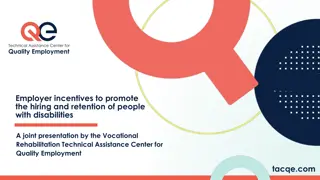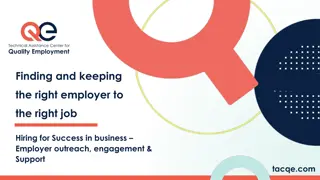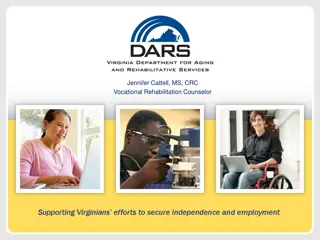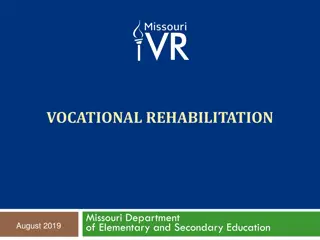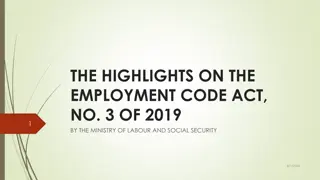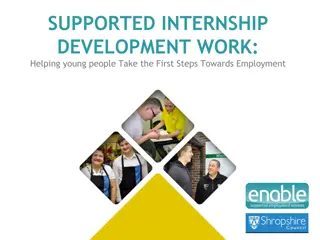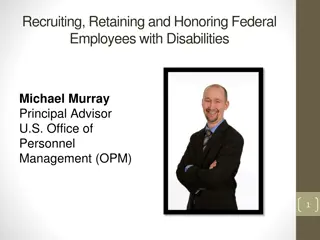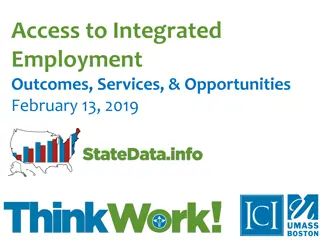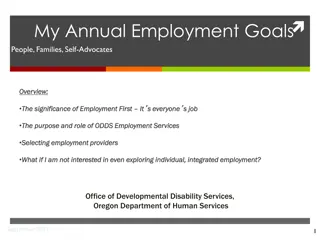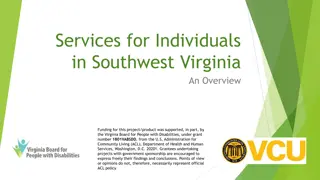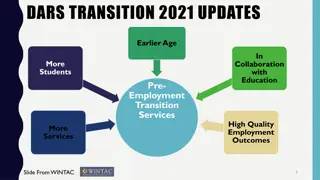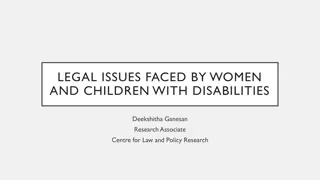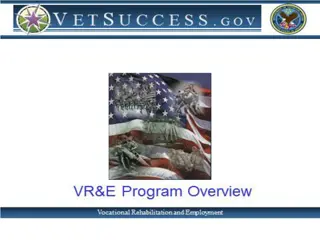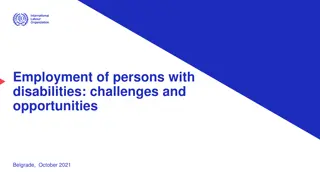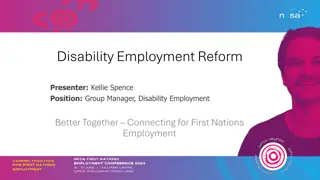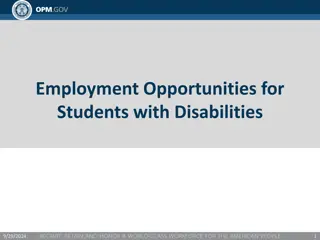Transforming Employment Opportunities for Illinoisans with Disabilities
Explore the journey from subminimum wage to competitive integrated employment for individuals with disabilities in Illinois. Gain insights into the impact of subminimum wage, current employment statistics, earnings disparities, poverty rates, and the significance of transitioning to fair wages. Learn how you can contribute to creating a more inclusive workforce.
Download Presentation

Please find below an Image/Link to download the presentation.
The content on the website is provided AS IS for your information and personal use only. It may not be sold, licensed, or shared on other websites without obtaining consent from the author. Download presentation by click this link. If you encounter any issues during the download, it is possible that the publisher has removed the file from their server.
E N D
Presentation Transcript
From Subminimum Wage to Competitive Integrated Employment for Illinoisans with Disabilities- SWTCIE Illinois Mr. Jim Knauf UIUC Project Manager Robyn L. Lewis, Ph.D. DRS Project Manager ICTW Symposium April 2023 1
Overview Session Agenda 1. 2. Overview of Subminimum Wage/ Sheltered Workshop 3. Impact of Subminimum Wage 4. SWTCIE Illinois Grant 5. Notice of Funding Opportunity 6. How you can help 7. Q & A Current employment data for Persons with Disabilities (PWD) 2
Disability Employment Statistics Labor Force Participation Rate September 2022, Working Age (16-64) (U.S. Department of Labor, 2022) (U.S. Department of Labor, 2022) 3
Percent employed Percentage of Individuals Employed 90.00% 79.60% 78.60% 80.00% 70.00% 60.00% 50.00% 40.70% 39.70% 38.80% 38.80% 40.00% 30.00% 20.00% 10.00% PWD: People with Disability PWOD: People without disability 0.00% PWD PWOD Difference United States Illinois (State) (United States Bureau of Labor Statistics, 2020) 4
Earnings Annual Earnings (40 hr work week) $60,000 $50,474 $50,000 $46,318 $40,303 $39,279 $40,000 $30,000 $20,000 $10,170 $10,000 $7,021 $7,280 PWD: People with Disability PWOD: People without disability SMW: Subminimum wage $0 PWD SMW PWOD Difference United States Illinois (State) _______ Federal Poverty Line (United States Bureau of Labor Statistics, 2020) 5
Poverty Rate Poverty Rate 15.60% Difference 14.50% 10.50% PWOD 11.40% 26.10% PWD PWD: People with Disability PWOD: People without disability 25.90% 0.00% 5.00% 10.00% 15.00% 20.00% 25.00% 30.00% Illinois (State) United States (National) (United States Bureau of Labor Statistics, 2020) 6
SMW Percent Living Below Poverty 25.00% 21.70% 20.00% 16.30% 15.00% 12.30% 10.70% 10.00% 5.00% 0.00% Min. Wage Subminimum wage No Disability Any Disability Moroto, M., & Pettinicchio, D. (2022). Worth Less? Exploring the Effect of Subminimum Wage on Poverty Among U.S. Hourly Workers. Socialogic Perspectives. Volume 1(21). 7
SMW. Subminimum Wage (SMW) Section 14(c) of the Fair Standards Labor Act of 1938 provides the legal foundation for subminimum wage 46 States (including Illinois) plus the District of Columbia use 14(c) waivers Certificate holders represent a broad group of industries including but not limited to: Hospitals/Residential Care Facilities; for profit businesses, educational programs, non-governmental community providers 9
SMW SMW Demographics Community rehabilitation programs represent the vast majority of 14(c) employers. According to the U.S. Government Accountability Office s (GAO) survey of 14(c) employers, almost all 14(c) workers had an intellectual or developmental disability, and most were White prime working age (25 to 54 years old). few 14(c) workers engaged in competitive employment (U.S. Government Accountability Office, 2023) 10
SMW Decline Subminimum Wage Decline April, 2023 954 (U.S. Government Accountability Office, 2023) 11
SMW IL Subminimum Wage Reach In Illinois, as of April 2023, 72 applications for 14(c) certificates 7.5% of the Nation s certificates 58 Active 14 Pending 3,294 employed under Active Certificates Estimated 4,090 employed under all 72 applications Nationally, approximately 120,000 were reported employed under 14(c) certificates, earning less than $3.50/hr. 12
Increase Wages Nationwide Call for Increase in Wages 30 States plus the District of Columbia, Guam, and the Virgin Islands have increased their minimum wages to exceed the federal minimum wage of $7.25 per hour January 1, 2023, Illinois increased its minimum wage to $13 per hour (non- tipped employees 18 and over). Minors may be paid $10.50 per hour. (Public Act 101-0001) It is still legal to pay people with disabilities below the federal minimum wage in Illinois (Subminimum Wage) 13
Legislation Transformation to Competitive Integrated Employment Act (TCIEA) (Feb 2023: U.S. House, Introduced) implement the goals laid out in WIOA (2014) provide grants to states or subminimum wage employers to help them transition to CIE. phase out the use of subminimum wage practices for all employers over five years prohibit the U.S. Secretary of Labor from issuing new certificates that permit employers to pay subminimum wages to workers with disabilities. 14
Legislation (cont) Nationwide Call for Increase in Wages (cont.) Legislation in IL Dignity in Pay Act (expected introduction Spring 2023 session) Executive Order Eliminating Subminimum wages on State Contracts (October 2021) States who have banned or have a plan for phase out: Alaska, Maine, Maryland, New Hampshire, Oregon, Washington, Hawaii, Colorado, California, Delaware, Tennessee, South Carolina, & Rhode Island. 15
SMW Impact Subminimum Wage Impact Exceptionally high poverty rates & compounded risk of family poverty Economic Insecurity Contributes to ongoing social problem disproportionately affecting PWD Adds to assumption PWD are less productive members of society Low-wage jobs=undesirable, undervalued, and low-skilled Wage theft and risk of exploitation Families with disabilities have inherently more expenses (support costs, medical, etc). 16
SMW Impact. 17
Competitive Integrated Employment Competitive Integrated Employment (long answer) CIE as defined in the Rehabilitation Act of 1973, as amended by WIOA . The term competitive integrated employment means work that is performed on a full-time or part-time basis (including self- employment) (A) for which an individual (i) is compensated at a rate that (I)(aa) shall be not less than the higher of the rate specified in section 6(a)(1) of the Fair Labor Standards Act of 1938 (29 U.S.C. 206(a)(1)) or the rate specified in the applicable State or local minimum wage law; and (bb) is not less than the customary rate paid by the employer for the same or similar work performed by other employees who are not individuals with disabilities, and who are similarly situated in similar occupations by the same employer and who have similar training, experience, and skills; or (II) in the case of an individual who is self-employed, yields an income that is comparable to the income received by other individuals who are not individuals with disabilities, and who are self-employed in similar occupations or on similar tasks and who have similar training, experience, and skills; and (ii) is eligible for the level of benefits provided to other employees; (B) that is at a location where the employee interacts with other persons who are not individuals with disabilities (not including supervisory personnel or individuals who are providing services to such employee) to the same extent that individuals who are not individuals with disabilities and who are in comparable positions interact with other persons; and (C) that, as appropriate, presents opportunities for advancement that are similar to those for other employees who are not individuals with disabilities and who have similar positions. The complete reference can be found here (pages 9-10)
Competitive Integrated Employment (cont.) Competitive Integrated Employment (short answer) Let's uncomplicate the issue .. The Workforce Innovation and Opportunity Act (WIOA) and Rehabilitation Act both define CIE in a consistent way: Work can be part-time or full-time and can include self-employment Wages and access to benefits must be fair and competitive Work settings must be integrated Opportunities for advancement must be equitable
The Problem Promoting CIE and Eliminating SMW Problem: SMW continues despite legislation (American with Disabilities Act [1992] & Work Force Innovation Opportunity Act, [2014]) to promote competitive integrated employment Continued resistance to change: Employers, Families, Sheltered Workshop lobbying organizations Solution: Evidence based practices including Supported Employment, Customized Employment, On-the-Job Training, Work Based Learning, Benefits Counseling, support CIE for individuals with all levels of support needs. Nationwide initiatives and grant funding 20
84.421 Disability Innovation Fund (DIF) Subminimum Wage to Competitive Integrated Employment (SWTCIE) Innovative Model Demonstration Project Funded by U.S. Department of Education- Rehabilitation Services Administration (RSA) The purpose is to support innovative activities aimed at increasing CIE for youth and other individuals with disabilities seeking or engaged in SMW employment. Illinois DRS was one of 13 states chosen for this award and received $13,943,946.00 for the period of 10/1/22 9/30/27, the second highest dollar amount. 21
Goals SWTCIE IL project goals Implement a statewide innovative, collaborative, and coordinated partnership model, Establish partnerships with at least six 14(c) certificate holders, Identify strategies for addressing challenges associated with access to CIE, Provide integrated services that support CIE, Support integration into the community through CIE, Identify and coordinate wraparound services for any individual served by SWTCIE Illinois who obtains CIE, Develop evidence-based practices and share those practices with other entities holding section 14(c) certificates, State Vocational Rehabilitation agencies, local rehabilitation providers, State and local workforce agencies, and regional and local employers, and Provide entities holding section 14(c) certificates with readily accessible transformative business models for adoption. 22
Model 23
SWTCIE: Project 14(c) Agency Outcomes Participant Outcomes Increased revenue sources/self- sufficiency Less dependence upon 14c contract work Status within the community Active participation in addressing local labor force issues Participants become contributing members to their community Provide Pathways to CIE for adults and youth with disabilities Integrated wrap-around services Community Integration Dignified Employment Increased quality of life 24
Beyond PWD Outcomes Beyond PWD Identify and address challenges to eliminate SMW statewide Create a manualized evidence-based program that can implemented statewide Establish stakeholder partnerships that will work together to eliminate SMW across the state Promote a strong diverse labor force to address the future labor employment needs across the state Promote economic development 25
Deliverables Notice of Funding Opportunity 1. Engage youth and adults with disabilities who are contemplating or currently employed under DOL 14(c) subminimum wage certificate. 2. Reassign/recruit, maintain, and develop at least two Employment Specialists with 100% dedication to SWTCIE Illinois project activities and who will undergo ACRE certification provided by UIUC. 3. Develop programs in partnership with SWTCIE Illinois project team and implement CIE activities for project participants such as: a. Supported/Customized Employment b. Benefits Counseling c. Job Exploration d. Post-Secondary Education e. Job Shadowing f. On the job experiences g. Internships or Apprenticeships 26
SWTCIE IL Activities Capacity building activities as outlined in SWTCIE IL build capacity to service and support participants in ways that will propel them forward in their future endeavors wherever their skills and interests may take them. build the skills they need to move from (or avoid in the first place) subminimum wage jobs, obtain CIE, advance in their careers, determine their own futures, and live independently in the community settings of their own choosing. o Skill promotion o Benefits counseling, Financial planning, o Transportation o Community integration & social inclusion 27
Notice of Funding Opportunity Person-Driven Plans Person-driven rather than placement-driven Focus on the worker skills and characteristics that are required in all five of the priority occupational and industrial sectors o essential workers, o green job workers, o home and community-based service workers, o arts workers, and o transportation and related industry workers. 28
Important Dates Notice of Funding Opportunity Posting: April 14, 2023 Accepting Applications: April 17-May 29, 2023 Technical Assistance Session: May 2, 2023; 10:30- 12:00; Via WebEx Link: IDHS: Subminimum Wage to Competitive Integrated Employment (SWTCIE) (24-444-30-3025) (illinois.gov) 29
How can you help How can you help? Follow our progress and access our resources via ICTW and website Spread the word of the NOFO Engage with your local VR office Engage with local adult service providers Engage with local businesses Redefine your expectations for ALL youth with disabilities Encourage Benefits Counseling 30
Solution How are you the solution Person centered planning Building work skills Capitalize on momentum gained in school Capitalize on relationships with local communities, families, etc. Prevent entry to SMW to begin with Extol competitive employment opportunities at every turn Direct VR referrals 32
VR Policy VR Policy allows engagement prior to HS exit (89 ILCS 590.760 ) Transition-means a coordinated set of activities for students or youth with disabilities, and outreach to and engagement of parents or, as appropriate, the representative of students or youth with disabilities. Students can be served by both the school and a Community Rehabilitation Provider (CRP) during their final year per counselor's approval. Special procedures must be followed for students under a STEP contract Students can be referred for Vocational Rehabilitation (VR) services through IDHS-DRS prior to being referred to a CRP per DRS counselor approval. An IPE is required prior to CRP services being initiated. IDHS: Transition Services Program Manual - FY23 (state.il.us) 33
Conclusion 34
Q&A Q & A 35
Resources Resources Bottom Dollars Film Actions - H.R.2373 - 117th Congress (2021-2022): Transformation to Competitive Integrated Employment Act | Congress.gov | Library of Congress Moroto, M., & Pettinicchio, D. (2022). Worth Less? Exploring the Effect of Subminimum Wage on Poverty Among U.S. Hourly Workers. Socialogic Perspectives. Volume 1(21). 36
Contact Us Contact Information Robyn L. Lewis, Ph.D. Division of Rehabilitation Robyn.lewis@illinois.gov (217) 606-9070 Mr. Jim Knauf UIUC jknau01s@illinois.edu (815) 830-4804 37


